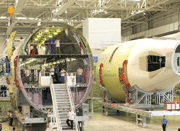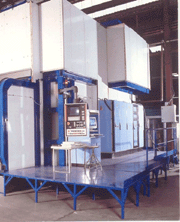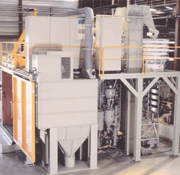E-Archive
Articles
in Vol. 6 - July Issue - Year 2005
Shotblasting Technology For The Giant Of The Skies

Airbus sets new standards for innovation and technology. The new aircraft can seat at least 555 passengers and will begin service in 2006.

The raw materials used in the new Super Airbus are of particular interest. The structural components of the fuselage are shot peened by R

An important aspect of shot peening is precise classification of the shot peening media. This picture shows the single spiral separator for removing unusable media.

10 axis CNC Shot Peening Machine

Shot peening machine with double pressure vessel for long-lasting peening process.
Airbus A380: A new dimension
It’s neither a World record, nor are they trying to impress you with size, they‘d rather you be impressed by economic advantages. The „Giant of the Skies“ will require only 2.9 litres (.75 gallons) of fuel per passenger per 100 kilometers (62 miles) and would thus be the first „Three Litre Aircraft“. The European aerospace company Airbus has achieved the primary technology goals for this through the use of innovative construction materials combined with better aerodynamics, system technologies and aviation electronics.
From a technology standpoint, the materials used in the construction of the Super Airbus are particularly innovative. About 25% of the A380 is made up of composites, 22% carbon fibre reinforced plastics (six times stronger and up to 60% lighter than steel) and 3% “Glare”. Glare is a laminate of alternating layers of Aluminum and glass fibre reinforced plastic that is being used in civilian aircraft for the first time. Glare is not only lighter than aluminium, but is also more fire proof and has higher fatigue strength. It also reduces the weight of the A 380 by 800 kg.
In addition to composites, the A 380’s construction includes a large percentage of high-tech metal construction materials, which also provides significant advantages in terms of weight reduction, operational reliability, ease of maintenance and repair. Aluminium alloys belong to this group, and various structural components of the Airbus airframe and floor plates are made of them.
Special shot peening machine combined with two robots
The structural components, which measure up to 10 metres by 3 metres, are partially shot peened in a special Rösler shot blasting system. A rail system transports the part into the shot blasting chamber, where it is shot blasted by the shotblasting nozzles of two robots which have been programmed to only blast specifically targeted areas of the component.
The internal compressive stress induced by shot peening the surface increases the distortion stiffness of the thin structural parts. Further advantages include higher resistance to corrosion and fatigue cracks. Components of other Airbus models besides the A 380 are shotblasted in the shotblasting system which measures 50 metres long and 6 metres high. The system has been designed for flexibility. However, the peening process must always be repeatable and the individual processing steps must be replicated year after year, in order to meet strict aerospace specifications.
Multiple media classification and strict process controls
In view of the enormous static and dynamic loads that are exerted on the fuselage, which is 7 metres wide and 8.5 metres high and over 70 metres in length, the requirements for the exactness and repeatability of the shot peening process are extremely strict. Therefore, continual and precise media classification is very important. The entire process is continuously monitored for possible deviations. Monitoring systems such as weighing cells and magnetic sensors, for measuring the flow rate of the shot peening media, or air pressure and air flow meters are used. The system is also connected to the Airbus Intranet. Rösler has utilized the results of many aviation projects in the design of this impressive shotblasting system.
Media classification and process control
Exact control of the peening process is required to ensure process repeatability and uniformity of each part and each lot in accordance with the given specifications. Size, shape, hardness, and quantity of the peening media must be strictly controlled. Air pressure (if air blasting is used) as well as air volume must be constantly monitored to guarantee absolute continuity and repeatability of the peening results.
Media classification is a multi-step process:
1. Separation of dust and particle fines (cyclone separator and/or airwash separator)
2. Classification by size (screen separation)
3. Removal of deformed peening media (spiral separator)
Shot peening parameters such as media flow rate, air pressure and air quantity are important process parameters for the shot peening operation, and must be carefully monitored and adjusted, as needed. To ensure process stability, Rösler shot peening systems are equipped with special monitoring and adjustment systems. The media flow rate can be pre-set and controlled by magnetic sensors for ferrous media, or weighing cells for metallic or non-metallic media. Air pressure and air volume are set and controlled by special valves.
Special attention must be paid to dust and fines removal, and media classification by cyclone and/or airwash separator, screen separation and spiral separator. Then the shot peening media passes through a screen to classify it by size. In the spiral separator, it is classified by shape, and deformed media is removed.
Shot peening system with different types of blasting media
In another shot peening system for large components, media classification is done by screen separators and spiral separators (outside right). Two types of peening media (S 170 and S 230) can be used. The double pressure vessel guarantees a continuous, even and long-lasting peening process without the need to interrupt the process to refill the pressure vessel. A minimum-quantity sensor in the lower pressure vessel is required to signal when media must be replenished. New media flows automatically from the upper pressure vessel into the lower without interrupting the peening process. After shutting the valves and equalizing the pressure with the atmosphere, the upper pressure vessel is refilled.
Application Areas
Highly stressed components such as springs and aircraft landing gears; aircraft parts made of aluminum alloys; blades, discs and shafts of jet engines and stationary turbines; compressor parts; connecting rods; crankshafts; membrane couplings; different types of shafts; and springs.
For Information:
Rösler Oberflächentechnik GmbH
Tel. +49.9533.924-0, Fax +49.9533.924-300
E-mail: info@rosler.com, www.rosler.com



























